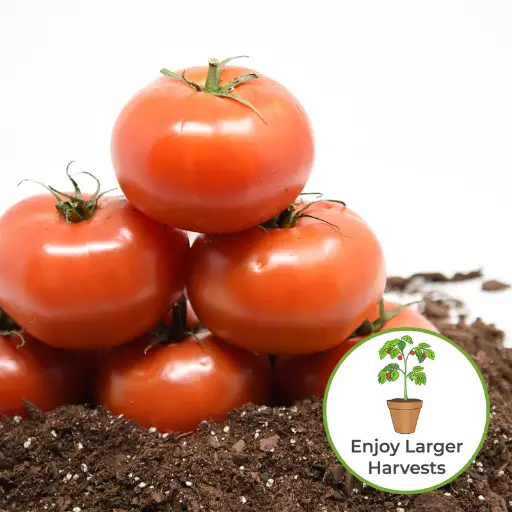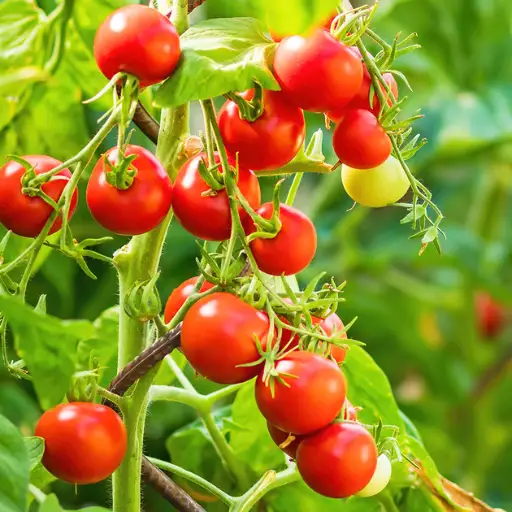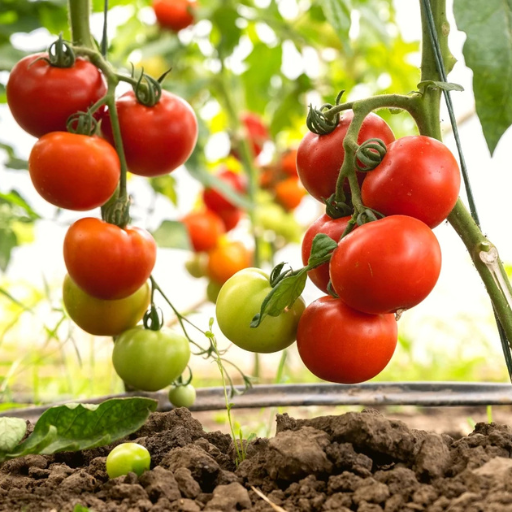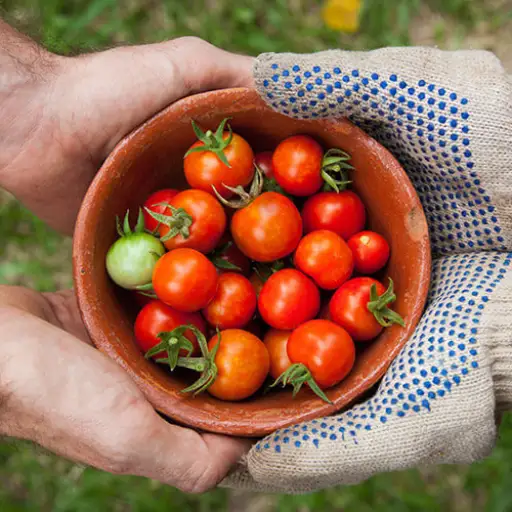Cultivating abundant and flavorful tomatoes requires more than just good soil and sunlight; it hinges on understanding the essential nutrient balance known as NPK—Nitrogen, Phosphorus, and Potassium. These three primary nutrients play vital roles in the growth and productivity of tomato plants. In this ultimate guide to tomato fertilizer, we’ll delve into how to choose the right NPK ratio to optimize your tomato harvest. Whether you’re a novice gardener or an experienced grower, gaining insights into tomato fertilization will empower you to achieve healthy plants and bountiful yields. This comprehensive guide covers everything from understanding each nutrient’s function to selecting the best fertilizers tailored for your tomatoes.
What NPK Ratio is Best for Tomato Plants?

The NPK Ratio in Relation to Tomato Plants
While deciding on the appropriate NPK fertilizer ratio for tomato plants, planning for both vegetative and reproductive growth needs to be considered as equally important. Yellow petioles or stunted stems are indicative of an NPK ratio such as 10-10-10 that would need to be used in the early stages of growth as plants are best leaf and stem inhibited. Or, when the plants start flowering and setting fruit, the phosphorus ratio rises and improves further on with products such as 5-10-10 or 5-10-5. Phosphorus makes roots stronger and supports strong blooming, whereas potassium helps avoid fruit diseases and improves its quality. By fine tuning the fertilizer to the growth stage of the tomato plants it is very possible that both the yield and the size of the fruit can be improved.
How Much Fertilizer Should You Use?
Fertilizing your tomato plants correctly entails the use of the right type of fertilizer, considering the quality of the soil and plant growth stage. It is generally suggested that 1 to 2 pounds per 100 square feet of garden Be applied for granular fertilizers. Alternatively, liquid fertilizers have to be diluted as specified in the label and are normally applied after every 1-2 weeks. There’s also a limit to fertilization as if plants are over-fertilized they will produce a lot of leaves at the expense of the fruits. Slapdash fertilizing may cause some nutrient deficiencies, and soil testing on a regular basis can customize the fertilizing to the wrong amount.
Best NPK Ratios for the Various Types of Tomato Varieties
Although different types of tomato varieties may have different preferences in terms of nutrition, these vegetables are usually provided with certain NPK ratios depending on the growing stage. Indeterminate varieties that produce fruits all through the growing season tend to prefer even NPK ratios such as 10-10-10 during vegetative stage. However, when they start flowering and fruiting, a more phosphorus rich blend such as 5-10-5 will be ideal. For example in determinate varieties that can be grown for a shorter period, they may begin with an even ratio and later on adopt 5-10-10 as they practice fruiting. Cherry tomatoes that grow rapidly and have short cycles of fruiting may however be responded by little raise of potassium due to improvement of disease resistance and other results concerning fruit productivity. The application of a brand of fertilizers depending on the variety helps in effective supply of nutrition in plants thus enhancing both the yield and quality of the crops.
How to Fertilize Tomatoes Effectively?
Timing of Your Fertilization to Achieve Maximum Growth
Tomatoes being vegetables require the twelve-month fertilization dial to be effective in terms of growth and yield. Have the first fertilization done at the time of planting through application of a balanced fertilizer in the soil, Lotting, A. Once the plants grow roots, usually a few weeks after planting, commence a feeding regime. For the vegetative stage, fertilizer application is done after 3-4 weeks, this time balanced or high nitrogen fertilizers are preferable to encourage leaf growth. Once the plants develop flowers, it is important to transition to high phosphorous and potassium-containing fertilizer, which encourages flowering and fruiting. Further, the plants need to be fed with nutrients every two to three weeks till the end of the growing period, and care is taken that the soil does not get dry during the period between the applications. The rate and degree of nutrient application can be altered depending on the plant, soil test results, or state. Plants, therefore, are fed with the fertilizers precisely when a given part of their growth is taking place.
Tomato Organic Fertilizer
The use of organic fertilizers for tomato plants also helps to regenerate the soil biology as well as feeding the plants with required nutrients for growth. Organic substrates like compost, good quality dried excreta and fisher emulsion, does not serve up all the nutrients at once but rather meet the same gradually thereby enhancing the degree of the inherent virtues of the land. These natural products contain several micronutrients as well as a wide variety of microorganisms that restore the healthy condition of soil ecologies that help to develop the plant’s immune system and often increase the assimilation of nutrients. For this purpose compost or manure should be added to the soil at planting and the plants should be top dressed with more organic material or liquid feed for example fish emulsion every few weeks during the growing period especially after transplanting. The constant application of organic fertilizers can achieve thick and healthy tomato plant structure with better fruits and less environmental impact.
Water Soluble vs. Slow Release Fertilizers
Water soluble fertilizers dissolve readily in water, which makes it possible for the plants to access the nutrients within the available period. This type of fertilization is useful where the plant is believed to be deficient in a specific nutrient, and therefore is done more often as it acts quickly. While, with slow release fertilizers, they are designed to release their nutrients over time in a more controlled way which also minimizes the risk for over-fertilization and frequency of use. These are helpful for relatively low work gardens where nutrients can be made available for the long growing season. Factors determining the choice of the two options include type of plants, time available for the gardener, and rate of growth desired. For immediate results or correction of particular deficiencies, water soluble fertilizers are good, while slow release type of fertilizers are good for extended nourishment and low maintenance.
What Nutrients Do Tomatoes Need?

Key Nutrient Elements For Good Tomato Growth
An adequate supply of nutrients will not only enhance the growth of tomatoes but will also ensure a quality fruit is yielded. The primary macronutrients include nitrogen essential in promoting leafy growth, phosphorus useful in root and flower formation, and potassium which helps develop the plant’s general well-being and the fruit’s quality. In addition, tomatoes need secondary nutrients: calcium helps in eliminating blossom end rot whereas magnesium is also important for photosynthesis. . Other mineral components such iron, manganese, and zinc can be categorized as micronutrients, although each to various degrees supports the chemistry and biochemistry of the plant. Such nutrients should be in the right Dosage and appropriate Soil Testing should be done so as to replenish macro and micronutrients of the soil organic or synthetic fertilizers được and as the situation might necessitate.
Understanding the Functions of Nitrogen, Phosphorus, and Potassium
Nitrogen is valuable because it encourages the growth of leafy green shoots and is a significant contributor to the process of photosynthesis. It enables the faster growth of the plant and the formation of strong stems and leaves. Coming to phosphorus, it is required for the formation of roots and the initiation of flowers. It facilitates the movement of energy, which is important for the plant to produce flowers and fruits. The importance of potassium in increasing the overall health of the plant including fighting off diseases and efficient water uptake is very common/known. It helps strengthen the cell walls, which aids the making of firm, succulent tomatoes. These nutrients, together, chemically work well in improving plant growth and therefore the amount of healthy and plenty of tomatoes harvested. Correlating these nutrients provision based on the requirements of the plant is very important, and soil analysis is advised in order to achieve this nutrient supply better.
Tomato Micronutrients Requirements
The owners of tomato plants are obliged to supply them with some of the most vital micronutrients including iron, manganese, zinc, copper, boron, chlorine, and molybdenum among others. Since iron is the most limiting micronutrient needed for the synthesis of chlorophyll, it determines the greenness of plants. In photosynthesis and in the metabolism of nitrogen, manganese is indispensable. Growth regulators require zinc, which also links to several enzyme systems that regulate plant development.
Copper facilitates reproductive activities and assists in lignin development, and the function of boron encompasses the cell wall and the building of fruits. Chlorine is important in the regulation of osmotic pressure as well as the regulation of stomata while Mo is important in the fixation and assimilation of nitrogen. Deficiencies of these micronutrients can cause hindrance to the growth of plants as well as yield of crops and therefore their supply through sound soil management and enlargement needs to be catered for.
How to Test Soil for Tomato Fertilization?

How to Perform a Soil Test to Check its Nutrients Concentration
First of all, they should collect soil samples from various places within the tomato garden in order to do a soil test for nutrients. Take note of a clean trowel and a small bucket with which you can place all the samples that you have taken and mix them to make one composite sample so as to have an accurate representation. After you have your composite sample, allow the sample to air dry and take out all the debris such as roots and stones where necessary. Take this specimen for analysis to your nearest extension service or an accredited laboratory that deals with soil testing. So, they will make such a sample with the level of pH and nutrient concentration: macro- and micronutrients. The recommendations will contain detailed information on the types of fertilizers which should be used and the appropriate amount on how much to apply in order to obtain maximum growth of the tomato plants. Such assessments are aimed at increasing the efficiency of utilizations of nutrients in the soil as well as ensuring that the plants are healthy and productive.
Understanding the Results of Soil Tests for Tomato Growth
Knowing how to read the results of a soil test for tomato crop care is important for improving the health and productivity of the plants. For starters, look at the pH levels. appropriate soil pH for growing tomatoes is 6.0 – 6.8 where plants enjoy nutrient availability. Lime would be added to increase the pH whereas sulfur would decrease the pH. Look at the levels of the macronutrients such as nitrogen N, phosphorus P and potassium K. Proper nitrogen supply encourages leaf formation, phosphorus is necessary for the roots and fruits, potassium enhances resistance against diseases and enhances plant well-being. If the test is found wanting in these nutrients, then there is a need to add balanced fertilizer or even some amendments. Some additional nutrients are needed, and calcium and magnesium are some examples; deficiency of such nutrients causes yellowing of the leaves or poor formation of fruits. Embracing the specific recommendations of your soil test results allows for the various kinds of fertilizers that would aid in the healthy growing of tomatoes.
Adjusting Fertilization Based on Soil Test Findings
When discussing adjusting fertilization based on soil test findings, one usually focuses on the tomato plants and how to try and better them by telling them how they should be treated differently. Start with the knowledge of the nutrient recommendations and its current status in your soil. For example, suppose the soil test shows that you have a nitrogen deficiency. In that case, you may choose to fertilize with ammonium nitrate or a greenhouse organic fertilizer to promote excessive leaf formation. There is a need to use phosphorus fertilizers on such soils so as to encourage more and bigger roots and fruit development. Potash can be applied for better plant health and disease resistance in case of potassium deficits in the soil. Also, if such tests pick up on shortage of micronutrients then some specific minerals’ amendments may be done including subsoil calcium with gypsum, magnesium with Epsom salts or iron with chelated iron. By doing so for each of these recommendations accurately, it becomes possible to improve upon the fertilization approach that will ensure that the tomato plants grows fully and even increases the productivity of the plant.
Best Practices for Growing Tomatoes

Selecting the Appropriate Container for Growing Tomato Plants
As for the pot selection, the key consideration is space and drainage efficiency. For small, determinate varieties of tomato, I prefer to use a pot with a diameter of about 18 inches, while bigger, indeterminate varieties, do best in pots of around 24 inches or more. Pots with drainage holes must be used so that the roots do not become waterlogged hence healthy growth. For the material, I tend to use ceramic or clay pots as these do well in maintaining soil temperatures, although I tend to use plastic pots at times because they are light and cheap. For successful tomato cultivation in containers, adequate watering and use of quality potting mix is also very important.
Watering Methods to Improve the Absorption of Fertilizer
To increase the fertilizers in my tomato plants, I ensure that I perform the deep watering regularly. I mostly do this in the early hours of the day to avoid losses through evaporation and so that the plants are able to take up water through the roots fully. The deep watering facilitates good root growth which is important for nutrient intake. For this purpose, I normally water when the upper inch of soil becomes dry to the touch. Moreover, applying mulch at the stems reduces the evaporation rates of the soil and prevents overheating of the soil giving better absorption of the nutrients from the fertilizers. Because of using these techniques, I am able to have the best results from the fertilization that I carry out.
Companion Planting and Its Benefits for Tomatoes
A lot of advantages come from this plant’s companion relationships to my tomato plants that allow the plants to grow bigger and better, while the diseases are more manageable. For instance, I have noticed that growing basil with tomatoes is good because the taste of the tomato increases, besides, aphids and whiteflies are fewer. Marigolds make a good companion plant too, their scent biological enhances the strength of soil nematodes other pests. Also, using borage near tomatoes is a good idea since it help draws in pollinators and improves the health of the tomato plants in general. From the kind of companion plants that I choose, I enhance the balance and the productivity of the garden ecosystem.
Reference sources
- Penn State Extension – Container Grown Tomatoes: This source discusses using a balanced fertilizer with a 1-1-1 ratio for tomatoes until they begin flowering.
- Cornell Cooperative Extension – Growing Tomatoes: This article suggests using a balanced 5-10-5 fertilizer for tomatoes throughout the growing season.
- University of Florida IFAS Extension – A Summary of N, P, and K Research with Tomato in Florida: This publication provides recommended nutrient rates for tomatoes, including specific NPK ratios.
These sources should help validate the feasibility of your topic for readers.
Frequently Asked Questions (FAQs)

Q: What is the best tomato fertilizer for growing tomatoes?
A: The best tomato fertilizer is often regarded as a specially formulated and balanced simple fertilizer which is meant for tomatoes. In particular, choose those fertilizers which have a higher ratio of P and K for better fruits and plant growth.
Q: How often should my tomato plants be fertilized with a fertilizer?
A: It is advised to add extension nutrients to tomato plants at an interval of 4-6 weeks within the growing season. This is because nutrient-needy plants like tomatoes are heavy feeders, and their growing period is limited.
Q: What types of tomato require different nutrient needs?
A: Various types of tomato may indeed differ in the kind of nutrients they need, but in general terms all tomatoes will respond well to fertilizer with nitrogen, phosphorus and potassium. Most crops that have high levels of feeding or nutrient requirement may in some instances require more frequent fertilizing especially more so when they enter the fruiting stage.
Q: Tomato plants can be fertilized with bone meal, can’t they?
A: Bone meal is suitable as a fertilizer for tomato because it contains phosphorus which promotes the growth and flowering of tomato plants. It can be incorporated in the growing phase, which tends to increase growth and yield.
Q: What is the best approach to assess the amount of nitrogen fertilizer needed by my tomatoes?
A: Usually a moderate level of nitrogen is needed for the healthy growth of tomato plants. Excess nitrogen input can result in an overgrowth of leaves and undesirable fruit set. Balanced N-P-K ratio fertilizer should be used at first and gradually modified as per the performance of the plant.
Q: Do tomato plants need kelp and if so how helpful is this fertilization practice?
A: Kelp is more useful for tomato plants as it contains trace elements and hormones that stimulate growth. Use of either the kelp meal or the liquid kelp may help in enhancing the nutrient uptake and general increase of the plants’ energy levels.






